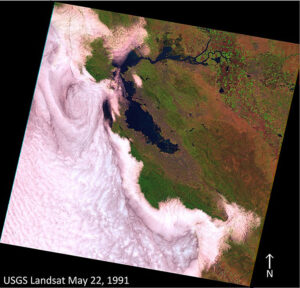By Steve McGuirk
Author and satirist Mark Twain once said, “The coldest Winter I ever spent was a Summer in San Francisco.” What he was talking about was fog. And certainly no other weather event in northern California is more fiercely contested.
If you live in Santa Cruz County and want a sunny Summer, fog is the bane of your existence. But if you’re a coastal farmer, or if you live in the San Joaquin Valley — where temperatures top out over 110 — it is the enshrouded blessing of being here.
So what is fog?
Retired meteorology instructor David Balough offers the simplest definition: “Fog is a cloud in direct contact with the ground or water,” an adequate description. What differs about fog is its formation, the means to an end.
There are different kinds, but because only several of them primarily affect those of us in the Monterey Bay region, we will deal with advection fog (that forms along the coast) and upslope fog (that forms along the mountains).
Coastal Advection
Around this time of year, the end of the rains and the increase in air temperature cause radiation fog which form above the irrigation of dark, open agricultural soils in our region’s farming areas. Coastal winds generally brush the ethereal fog as the day grows warmer.
But in the summertime the marine fog that occurs along coastal areas with climates similar to California’s — Chile, Peru, South Africa, and the Canary Islands — is a result of complex air, land, and sea interactions that occur along the eastern edge of ocean basins.

Fog’s microscopic water droplets form when they encounter a cloud condensation nucleus. The nucleus around which fog droplets can form can be any microscopic airborne particle such as salt or other ion, molecule, dust, pollen, metabolically-active bacteria, protozoan, fungus, or biogenic fragments (produced or brought about by living organisms).
Breaking ocean waves and bubbles bursting from foamy whitecaps produce sea-spray droplets that evaporate into sea-salt aerosols, relatively large, moisture-attracting cloud condensation nuclePhotosi. Sea-salt aerosols attract and hold water so efficiently that fog droplets can even form in unsaturated air. This is most often observed as a mist hovering over the ocean on a warm summer day along the California coast.
As the warm air travels southeasterly, it stirs up the waters of the Monterey Bay, and at the same time, summertime temperatures rise in deep, adjacent valleys, the largest of which are the Salinas and Santa Clara. And as hot air rises in the backs of these valleys, moisture-laden air is drawn landward from the Current to fill the void.
When the fog comes ashore, its movement is at the mercy of hot valleys and landforms. In the Monterey Bay region, the most powerful rising column of warm air is over the Salinas Valley.
But as the fresh fog moves down the length of the Salinas Valley, it encounters the bottom of the Santa Clara Valley, where warm air is also rising. Part of the fog layer pulls off the main bank and turns north, in diametric opposition to the mass that moves deeper into the Salinas Valley.
Subsequently, as this portion moves northerly — where it will eventually combine with fog moving southerly from the Golden Gate — it encounters the southern flank of the Santa Cruz Mountains and is deflected westerly over Watsonville, coalescing with a finger of fog that has been pulled up into the Pajaro Valley watershed. Finally the links are made and we settle into the gray reality of our living here.
And whereas it might make your day at the beach unpleasant, it is essential for the growth and sustenance of much of the vegetation in our region, and especially the Redwood tree, whose needles are uniquely shaped for the collection of the airborne moisture fog brings with it.
Upslope
As you drive over Highway 17 towards San Jose you may experience two kinds of cloud or fog types close to the Summit. The first is simply the bottoms of clouds sitting on or above the mountain tops and encountered primarily during the rainy season.
The second kind is upslope fog. On your drive over 17, you may enter fog around the Laurel Curve, but you will pass through it by the time you are at, or just over, the Summit. This fog forms adiabatically — the process that causes sinking air to warm and rising air to cool.
As moist winds blow toward a mountain, they up-glide and this causes the air to rise and cool. The cooling of the rising air pushes it up with its related dew point temperature, where water in the air condenses into visible droplets. Fog forms at or near the tops of the mountains. Upslope fog appears as a stratus clouds — low lying layers with either white or grey coloring.
If you’d like more information, check out the Coastal Fog Project, from which much of this information was drawn. It is a production of the United States Geological Service (USGS) online at www.usgs.gov/centers/wgsc/science/pacific-coastal-fog-project?qt-science_center_objects=0-qt-science_center_objects.
You can also learn how to forecast the likelihood of fog by reading Jeff Haby’s list of characteristics at www.weather.gov/source/zhu/ZHU_Training_Page/fog_stuff/forecasting_fog/FORECASTING_FOG.htm
Contemporary Turkish playwright Mehmet Murat Ildan once wrote, “When you are happy, you feel the sunshine even inside the fog; when you are unhappy, you feel the fog even in the sunshine.”
Be happy and learn to accept this essential part of coastal living.
•••
Steve McGuirk is a retired landscape architect and enjoys writing about the natural elements of the Monterey Bay region. He lives in Soquel.